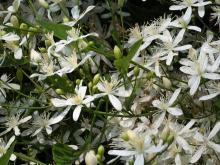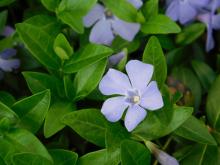Wildflowers, Grasses and Other Nonwoody Plants
Media

Species Types
Scientific Name
Clematis terniflora
Description
Sweet autumn virgin’s bower, also called autumn clematis, is a nonnative, invasive perennial vine that spreads aggressively and climbs rapidly over any support. In late summer, it produces dense clusters of white, sweet-smelling flowers, which mature into fuzzy seed masses.
Media

Species Types
Scientific Name
Cuscuta spp.
Description
Dodders are easy to identify, even though at first you might not recognize them as plants. These parasitic plants usually look like a hairlike mass of yellow or orange, leafless, wiry, vining stems wrapping around the stems of other plants.
Media

Species Types
Scientific Name
Glechoma hederacea
Description
Ground ivy, or creeping Charlie, is a creeping, nonwoody plant that often forms loose mats. A native of Eurasia, this member of the mint family has been introduced nearly throughout the United States. It is considered a lawn and garden weed.
Media

Species Types
Scientific Name
Vinca minor
Description
Common periwinkle is a low-growing, mat-forming, purple-flowering perennial that is woody at the base. Native to Eurasia, it is often grown as a groundcover. It has proven invasive in much of the eastern United States and frequently escapes from cultivation. Planting it is not recommended.
See Also
About Wildflowers, Grasses and Other Nonwoody Plants in Missouri
A very simple way of thinking about the green world is to divide the vascular plants into two groups: woody and nonwoody (or herbaceous). But this is an artificial division; many plant families include some species that are woody and some that are not. The diversity of nonwoody vascular plants is staggering! Think of all the ferns, grasses, sedges, lilies, peas, sunflowers, nightshades, milkweeds, mustards, mints, and mallows — weeds and wildflowers — and many more!





















